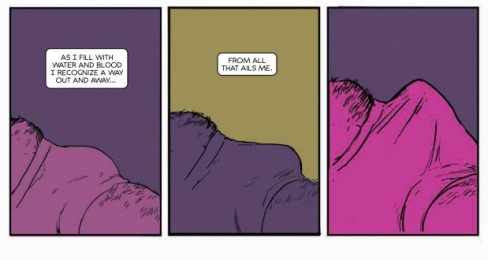When someone says they are writing their “Cerebus,” it’s hard not to say: Well, Ok. If you have over three hundred issues of story to tell me, then show me a plot setup that can convince me that there is enough material to go through, and examine, and uncover!
If you start reading Material looking for road-signs, you will miss the beauty of its fullness. It’s overloaded. Everything, and everyone is asking to take your attention. Kots and Tempest know: Ephemeral isn’t kind, or pretty, or neat.
“Material” #1 does a good job at calling this Cerebus bluff (because now, of course, I’m holding Kot and Tempest and the wonderful letterer Clayton Cowles to be making thirty+ years of art), by giving the reader multiple story-lines with radically different conflicts.

Written by Ales Kot
Illustrated by Will TempestWhat is Material? The better question to ask is what isn’t Material. Defying genre-cateogies, and bringing back the 9-panel comic set up, Material sets to interweave four narratives, exploring the nature of what it means to be human. A philosophy professor is contacted by an AI. A boy is knocked out in a rally, and joins a revolution. A drug-addled actress is brought into a new movie production to revive her career. A man comes home from Guantanamo Bay, unable to love his family. Material is asking a lot of questions, but mainly, what does it mean to experience life “truly” and how do we replicate that?
The transitions in this first issue of this massive arc is what makes the story more intriguing than frustrating.
Some transitions are very literal, and playful, like: Zoom in on our soldier character’s boxes, as in he lays, despondent in a sex dungeon admitting to the reader that sex is one of the only ways he can cure his ailments of his soul, and then having the next panel be a shot of our aging philosopher’s wrinkled face admitting he feels “impotent” at his work.


Yet, other transitions are masterfully subtle, and cinematic. For example, we can read an email of a person, insulting our philosopher, and switch to a board-room where a nameless producer is telling our actress character that she is “perfect just the way she is.”
Tempest’s artwork helps the jarring aspects, by choosing to acknowledge it in his panels. He knows how to play with our perception as he chooses to alternate color panels, flipping the pattern of colors from panel to panel. Its affect on any given page is equal parts disorienting, and also, masterfully used to provide insight to character. My favorite: In the opening scene with our professor, one person that leaves the professor’s lecture and is colored in yellow, while the rest of the room draped in blue, as if the professor could only see that one person leaving, letting the rest of the faces in the room blend together, meaninglessness for him. Heartbreaking.
If the story’s layering of characters seem overwhelming, each characters’ introduction makes up for it in spades. Of course, Nylon’s panels would be monetizing everything around her, as she sees herself as more of net worth than person. Yes, someone would have to be challenging and walking out of our jaded professor’s classroom as he is delivering an anti-technological-worldview with the the word on the chalkboard behind him “atempo” (which could either be Atempo–the database management system that saves everything you do, for you, or “a tempo” which means to go back to the original tempo you started out with, ok, too clever?). Our boy is first seen being knocked onto the pavement at a Michael Brown rally, to later find a Black Panther book. And there is our soldier, having flashbacks to being water-boarded as he is being sexually aroused in a dungeon, to later be uncomfortable when cuddling with his wife. I might not know who these people are, but I know their trouble. And that is the hook that has me.
Style points, also, to the footnotes. Footnotes! At the bottom of each page there is a comment, or citation, to something happening in the panels at any given time. The footnotes are trying to reach you, or failing to, much like the status of most of these characters in the text who are hopelessly disconnected, but searching to find a connection back to life. Or, maybe, a place to hide clues?
JUST SAYIN! Patient readers like rewards.
Final Verdict: 7.5–a tale bursting at the seam, waiting to reveal its intricate, colorful tapestry; a read for the curious, and patient reader, who likes to be teased, and questioned in what they think will happen



